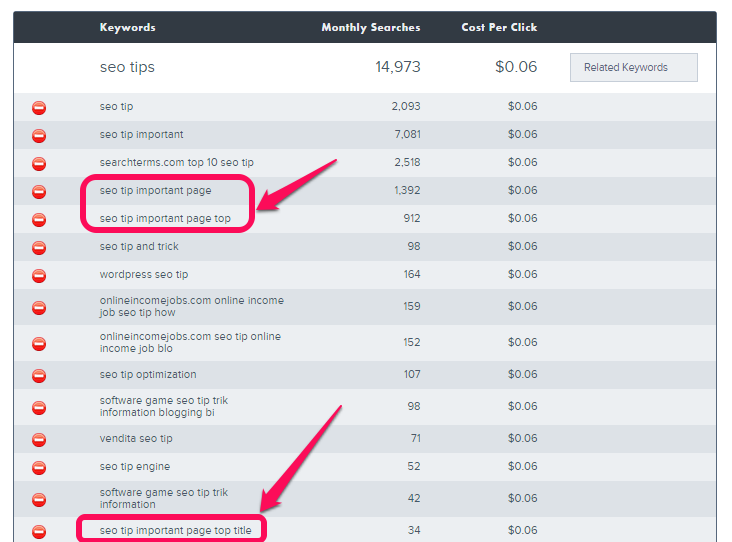How To Generate 20,000 Monthly Visitors Through Long-Tail Search
Do you want more search visitors?
Search engines aren’t the only source of targeted visitors, but effectively targeting long-tail keywords in your content can greatly increase your monthly search visitors.
I’ve generated 173,336 qualified visitors from long-tail keyword phrases in the past year – a 91% increase.
Your long-tail keywords may not rank in Google’s top 10 results and it’s true that 60% of all organic clicks go to the top 3 search results, but that still leaves 40% up for grabs.
If you consistently publish in-depth content around long-tail keywords, you’ll see an increase in search traffic, attract paying customers and grow your brand.

Now that you know the potential impact of long-tail key phrases on your site growth, let’s dive in and learn how to sustain that organic traffic.
In this article, we’ll cover these four topics:
- How to research long-tail keywords
- Case studies on long-tail keywords
- Ranking elements for long-tail keywords
- Tools to help you pick the right long-tail keywords
Download this worksheet to learn more about the use of long tail keywords within your content.
1. How to research long-tail keywords
Many people think that keyword research is no longer important. But, that’s not true. In fact, research – particularly of long-tail keywords – can help you craft the kind of content that engages and inspires readers.
A research study by Statista shows that successful on-page optimization requires 50% of your focus to be on long-tail keywords.
One of the questions I get asked weekly is: “How long should a long-tail keyword be?” And, my answer has always been “four keywords or more.” The longer the keyword, the easier it is for you to rank well for that keyword.
Here are some examples of good long-tail keywords in the fitness niche:

To research your own long-tail keywords, follow these simple steps:
Step #1: Start with seed keywords. Let’s assume that you want to target the keyword “copywriting.” To find long-tail variations on that seed keyword, go to the Google Keyword Planner and type in copywriting. Then, scroll down and click “Get ideas.”

Step #2: Click on the keywords tab to show all of the keywords related to copywriting.

Step #3: Look for the most relevant in-demand keywords. Make sure that the keyword you selected is relevant, because you’ll be expanding on it for longer variations.
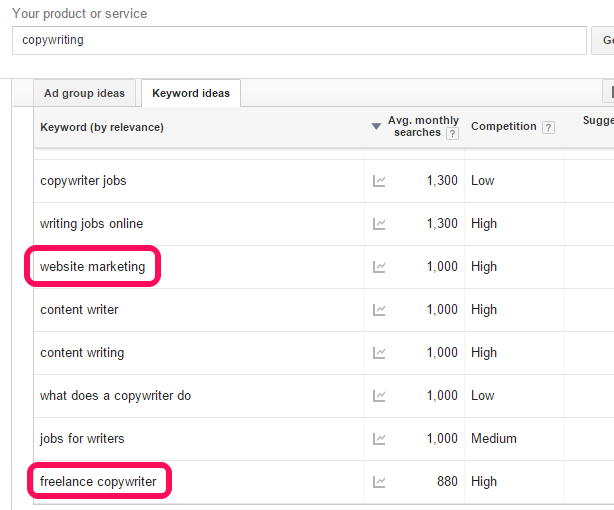
Step #4: Copy one of the keywords highlighted in red above and plug it into the search box for long-tail variations.

Note: To generate up to 50 long-tail versions, follow these three simple steps:
Step one: Visit 7search and click on the Advertisers tab.

Step two: Click the “enter your keywords” tab to continue.

Step three: Enter your keywords – e.g., SEO tips – then click the green button.

Step four: Identify long-tail keywords herunterladen.
- seo tip important page top title
- seo tip important page top
- seo tip important page
Note: To use these keywords for a piece of content, write a single piece and use each long-tail keyword for your subtitle and bullet points.
Understand long-tail keyword intent: The intent behind any particular keyword is much more important than the keyword itself. According to Tom Fanelli, “when you think about intent, good keywords will follow.” Your content will improve as a result.
Long-tail keywords that address the need of the searcher or solve a definite problem will most likely rank well on Google, compared to similar head keywords.

When you use a keyword strategy, don’t be perturbed by Google’s algorithm changes. Focus on what really matters and you’re golden, says Search Engine Land.
Customers who type descriptive key phrases (long-tail) are generally more qualified than those who type head keywords. As a result, the conversion rates are higher for long-tail keywords, as compared to head keywords.

But, most customers aren’t ready to buy yet. Some prefer to browse, while others want to learn about the product before placing their order. What buying cycle does your keyword fall into?

If consumers haven’t made up their mind to purchase, they’ll probably search for “informational keywords.”
Examples:
- how to lose weight workouts
- search engine optimization tips
- make money online with no money
- make money on the internet free
- free ebook download
- top 10 free plugins for WordPress
However, when searchers are ready to buy, they use keywords displaying commercial intent.
Examples:
- survival knife review
- buy fire TV
- weight loss programs
Commercial keywords usually contain certain prefixes (words that appear before) or suffixes (words that appear after), which modify or qualify the long-tail keywords. Here are some of the popular ones:
- Buy
- Review
- Purchase
- Discount
- Coupon
- Deal
- Shipping
- Order
You’ll usually find both informational and commercial intent keywords in your research. With consistency, you can improve your search ranking by targeting the keywords with useful and detailed content. Here’s an example:

2. Long-tail Keywords Case Studies
So many bloggers and website owners are now taking full advantage of long-tail key phrases, because these search terms are low hanging fruit – easier to reach and pick. Long-tail SEO is all about filling a void, answering a question and helping search users save time.
Case study #1: In 2013, Michael Aagaard wrote a detailed post about call-to-action examples.
Within a short time, that page started ranking in the #2 position in Google SERPs. The page continues to get over 1,000 visitors per month from the search engine.
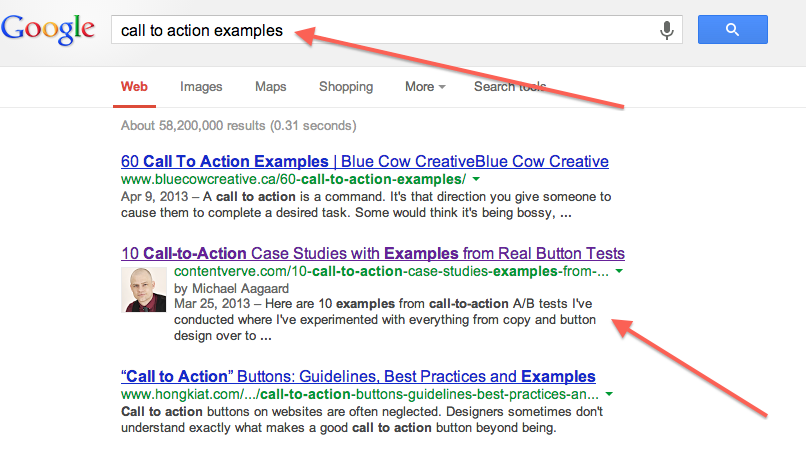
The screenshot below shows the monthly traffic from a single long-tail search term (“call to action examples”):

Case study #2: Tresnic Media increased their website traffic by almost 438% and then by 1,000%, in eight weeks, through blogging.
They published 50 highly valuable blog posts, each targeting a long-tail search query. Google recognized and rewarded them with high rankings and improved search traffic.

Case study #3: Tamal Anwar also increased his search rankings and daily traffic by targeting longer variations of certain keywords filme aus mediathek downloaden legal.
He now generates 80-90% of his monthly visitors from search engines, as a direct result of writing highly useful content on trending topics.

Case study #4: Marcus Sheridan, founder of River Pools and Spas, wrote an in-depth blog post targeting the keyword “problems with fiberglass pools.”

Even though he’s not ranking #1 for the head keyword (fiberglass pools), this single web page ranks #1 in Google for the long-tail keyword. It also generated over 5,000 views when it was published.

Currently, my goal is to build this blog to 100,000 monthly visitors. In February, this blog generated 46,134 visitors and I know it’ll definitely increase in March.

Some of the in-depth articles that I wrote in the last four months rank highly in Google results. For example, I targeted a long-tail search term (how to write email subject lines) in October. Check out my current search ranking position:

Some of the benefits of targeting long-tail keywords are:
1). Boost your search rankings: On average, Google’s top result gets 36.4% of the clicks. But, that leaves a lot of traffic up for grabs.

Spend your time crafting the best content possible for your target audience, then promote it to the right people. You can even repurpose your content, so that people will continue to benefit from it.
If you’re struggling to achieve good rankings in search results, there could be any one of 13 reasons why that’s happening. One of the most common reasons is duplicate content on your site. To resolve that problem, eitherremove the duplicate content or make it unique.
Once that has been done, focus on your audience. Write content that solves their problems and optimize it properly for search. Instead of focusing on long-tail key phrases just for the fun of it, focus on user intent.
On-page keyword usage is still one of the major ranking factors for content and it can’t be ignored in today’s SEO.

That’s where easy rankings lie. It doesn’t matter how competitive a long-tail keyword is; if users are happy after reading your content, watching your video or listening to your podcast, they’ll be happy to share it.
Get more search visitors: At the end of February 2014, I was surprised to learn that my blog had attracted 238,195 search visitors herunterladen. 100% of them came from long-tail keywords.

Since user intent is more important than the keyword itself, Google will reward you with more search traffic, as long as your content is helpful. For example, let’s say the long-tail keyword you’re targeting is:
weight loss guides for beginners
As you write and publish detailed articles of at least 2,000 words, you’ll gradually start showing up in Google for related long-tail search terms, such as:
- best weight loss guides for beginners
- beginners weight loss guides
- free weight loss guides for beginners
- download weight loss guides
And so on…
So, to reiterate: when you start ranking for several related long-tail key terms, your search traffic will increase.
Ogio Golf Bags gets lots of organic traffic from more than 50 search queries. But, the author (a friend of mine) targets less than ten long-tail keywords.

Some of the long-tail keywords that are performing well for him are:

3). Improved conversion rate: SEO and CRO play well together. When you target that low-hanging fruit, your conversion rate will definitely improve.
Everything has to work together. That includes your content, site load time, call-to-action etc. Everything is important, because on-site conversion begins from site design.

Search users usually convert across different industries. But, as Marketing Sherpa noted, you have to focus on the most effective keywords for each stage of the buying cycle.

In other words, make sure that your landing page is designed with the user in mind.Otherwise, nothing else will matter – not even your content.
G3 Group increased their conversion rate by 14%. They used a blend of SEO and PPC and they now average about 5-10 qualified requests per day. This shows that targeting longer variations of profitable keywords on both free and paid search increases your conversion rate.

Alex Cooper was faced with the challenge of attracting a national audience to its shopping site. Of course, if you only ship goods within your own country, there is no need to target a global audience.

But, as soon as Alex Cooper researched long-tail key phrases and created useful content around them, the site began getting more traffic from over 500 keywords.Most importantly, the company reduced its PPC spending by 50%.
Take Me Fishing focused on content optimization, which increased their traffic by almost 1,000%. The site began ranking #1 in Google for a profitable and in-demand keyword, “best fishing spots.” They also reduced the site’s bounce rate and enjoyed an increase of 946% in organic traffic, year over year.

Long-tail keywords myth: Since the release of Google Hummingbird, many people have been laboring under misconceptions about keywords. Some even advised against keyword research.
I’ve shared several success stories from individuals and corporate sites that increased their search rankings and traffic, simply by focusing on long-tail key phrases roblox downloaden op laptop.
However, there are still some SEO myths that you should ignore:
i). Myth 1: Target long-tail keywords only. A typical keyword that your target audience is searching for usually comes in two variations: short and long keywords.
If you over-optimize for either of these keywords, you risk getting penalized by Google. Next thing you know, your traffic trend starts looking like this:

Another problem is the excessive use of either type of keyword as anchor text. Focusing on just the longer keyword variations in your content is an SEO myth.

Of course, if you include content built on long-tail keywords, based on user intent and designed to help your reader instead of on manipulating your rankings, you won’t have to worry about Google Panda or Penguin updates.
The major reason why you should target short-tail keywords, in addition to long-tail key phrases, is because the longer the keywords, the lower the search volume.
This also means that it’s going to take a lot of time before you see significant results in both traffic and rankings.

ii). Myth 2: Always use the exact long-tail keywords in your headline – This advice may seem harmless, but it’s not the best approach. Sure, there are several benefits to targeting this type of key term, but there are also drawbacks.

Be exceedingly mindful of what you add to your headlines. They’re the first thing that users see and they’re what motivate or discourage clicks.
The rule of thumb is this: If you research and discover a keyword that flows smoothly and naturally when you read it, then feel free to use it in your headline. Otherwise, it can result in keyword stuffing and a low-quality content penalty.
For example, these keywords flow smoothly:
- buy kindle fire hd
- affordable NY SEO expert
You can use these keywords in your headlines. For instance:
- Buy a Kindle Fire HD: 5 Things You Should Know
- Where To Buy a Kindle Fire HD and Get Free Shipping
- How To Find An Affordable NY SEO Expert
- How to Hire an Affordable NY SEO Expert In Your City
In contrast, the keywords below look spammy and should not be used in your headlines:
- Kindle fire hd buy free shipping
- SEO expert NY affordable
The above keywords have commercial intent, but they don’t look or sound natural at all. If you add them exactly as they appear in your headline, you’ll confuse users and chase them away. You could even get a Google penalty.
iii). Myth 3: Long-tail key phrases are less expensive – Most PPC advertisers think this is true, but it’s not necessarily so. Dig deeper and you might find some expensive long-tail phrases.

Even SEO experts know that most keywords that fall into this category are expensive and take time to improve your organic rankings.
In the same way, the suggested bid on most long-tail search queries is very high, because of the perceived value, demand and intent behind the search.

Bottom line: SEO is a long-term practice. Don’t expect sudden overnight increases in rankings and organic traffic. However, it’s possible to achieve tremendous search results in a matter of weeks angry birds download kostenlos pc.
For example, Brian Dean increased his search traffic by 110% in just 14 days. Of course, social sharing, trusted inbound links and editorial citations contributed to this huge success. But, the most important factor was the quality of his content.
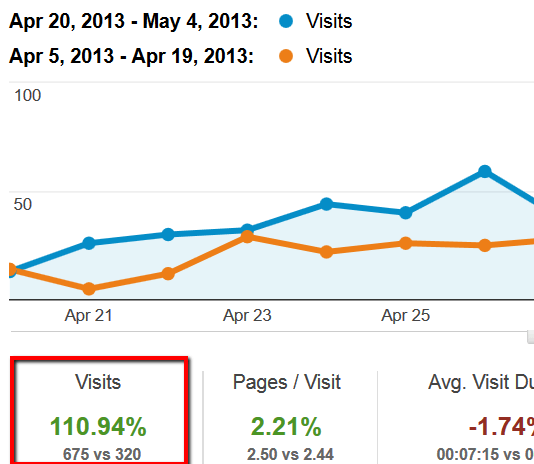
iv). Myth 4: You should aim to be on the first page of Google results. Even though SEOs, bloggers, website owners and content marketers want that #1 Google ranking for their most profitable keywords, that’s just not a good goal to adopt. It’s not an actionable metric.
In fact, in today’s SEO, it’s possible to grab that #1 position and still not generate enough clicks, leads and sales.
There is really just one reason why most headlines aren’t clicked: the headline doesn’t inspire searchers to click.
Headlines not clickable: Getting users to click your link on those result pages is crucial. If your headline doesn’t inspire search users to click it and visit your site, you’re doomed.
Headlines that begin with “How to” or that contain a number tend to get more clicks, all things being equal (assuming the link is on the first page of search results).
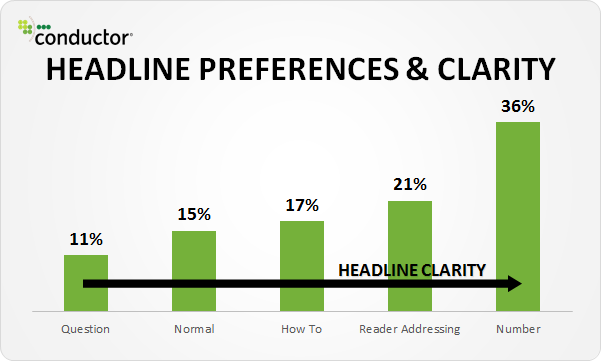
For example, let’s review two headlines. Both target the same users. And, they are currently sitting in the #1 and #2 positions, respectively.
Be honest: if you knew someone suffering from arthritis in the hand and you wanted to help them find the right solution, which of these headlines would you click?

The first search result isn’t clickable – but the second is. Optimizing your content to captivate people and appeal to their emotions is the best SEO approach.
When your headlines don’t inspire, people won’t click. Or, sometimes they might decide to click, but quickly click the back button, in order to check out the catchy headline that’s attracting them.
When that happens, your rankings will gradually drop, because Google will conclude that users aren’t satisfied with your content.
Note: A great headline catches people’s attention, but it can also motivate you to write in-depth content. It can even give you ideas for subtitles, bullet points and calls-to-action.

Finally, write your headlines in sentence case. Don’t capitalize every word and don’t write in lower case. Research shows that 64% of search users will respond to relevant headlines that are written in sentence case.

Sentence case doesn’t look like this:

It looks like this:

3. Long-tail Ranking Elements
In this section, we’ll discover the important elements that will give your long-tail keywords a boost in the search engines.
When users type a particular keyword into the search box, Google uses up to 200 factors to determine how relevant, useful and authoritative your content page is for the given term, before ranking it.

According to Inforza, “93% of online experiences begin with a search engine.” This means that even before your users get fully involved with Facebook, Twitter and LinkedIn, they’ll use a search engine first herunterladen.
Let’s review some of the core elements that will get you top rankings when you target long-tail keywords:
- Keyword-rich Headlines
- Internal Linking
- Trusted Links
- Social Engagement
1). Keyword-rich headlines: Front-load your headline with relevant keywords. Most people scan the first two words of your headline to determine whether or not it’s relevant to what they’re looking for.
For example, the most shared content relating to the keyword “monetize a blog,” had the keyword or a variation of it before any other significant word.

I write keyword-rich headlines and this has contributed to over 100,000 monthly visitors to all of my blogs. I also grew the KISSmetrics blog from 0 to 350,000 blog readers per month with this strategy.

Let’s write some clickable and keyword-rich headlines, using some of the long-tail key phrases below:

The search terms are:
Making money from home
Stay at home jobs
How to make extra money
a). Headlines for making money from home:
Making Money From Home: 5 Steps You Should Take
How Making Money From Home Is Possible in 3 Steps
7 Tips For Making Money From Home That Work
b). Headlines for stay at home jobs:
The Top 5 Stay at Home Jobs That Pay
Stay at Home Jobs: How to Get Started in 15 Minutes
10 Stay at Home Jobs That Pay Every Week
c). Headlines for how to make extra money:
How to Make Extra Money With Affiliate Marketing
How to Make Extra Money to Pay Your Monthly Bills
Another approach is to find a very popular article with thousands of social shares and improve it by making it your own.
This is how to do it:
Step #1: Go to Buzzsumo. Type in the keyword (e.g., social media strategies) that you want to use for your headline. Then click “Go.”

Step #2: Analyze your results and pick headlines that you can improve.

The headlines that we want to make keyword-rich are:
- The Top 15 Social Media Marketing Strategy Mistakes to Avoid
- How to Build a Content Strategy Using a Social Media Audit
From the main keyword (social media strategies), you can tell that neither headline above is really targeting it.
More so, the user intent isn’t accounted for. People who are searching for the given keyword are probably looking for ways to promote their online business through social media marketing. They don’t want to audit their site or discover social media mistakes.
So, let’s make the headlines keyword-rich, relevant, clickable and sharable. Remember our target keyword is: social media strategies.
Original headline: The Top 15 Social Media Marketing Strategy Mistakes to Avoid
Fresh headlines:
- Social Media Strategies: How to Attract Buyers Through Social Media Marketing
- Top 10 Social Media Strategies For Lead Generation That Work
- The Exact Social Media Strategies I Used to Increase Conversion Rate By 382%
Original headline: How to Build a Content Strategy Using a Social Media Audit
Just-created headlines:
- How to Use My Proven Social Media Strategies to Improve Your Sales
- Social Media Strategies: My Foolproof Twitter Marketing Techniques
Caution: Avoid keyword stuffing. How? When you use a keyword in your headline, make sure that you limit its usage in the body. Your keyword density should be less than 1%. Focus on helping people, not manipulating search rankings.
2). Internal linking: The second element that will help you succeed at long-tail keyword targeting is internal linking alte kinderserien downloaden. Internal links are usually hyperlinks that point to web pages on the same domain.

Pay attention to what’s happening within your site, because that’s something that you can completely control. That’s also why Google looks seriously at the links pointing to your internal and archive pages.
What makes Wikipedia the #1 content site in the world? It’s diligent about linking to internal pages, no matter what the subject.

The above article on Wikipedia links to over 50 other pages. Linking to important pages on the same domain heats up the page and passes more juice or value to it.
When you consistently link to internal pages in your content, Google will assume that you care about user experience. That’s important, because there is virtually no single piece of content that will address every question your user is asking.
By linking to your already-published articles, you’re meeting your user’s expectations and engaging them. And, the more links they click, the more time they’ll spend on your site – thus increasing the authority of your site.
In summary, here’s how to do internal linking:
- Link to other relevant content pages. For example, if your new article is about Twitter marketing, you could link to previous articles on Facebook marketing or articles related to social media tools.
- Add breadcrumbs to make navigating your internal links easier for your user.

- Make sure the pages you’re linking to are unique and helpful. This is really important. Google hates duplicate content.
- Link to the entire web page, not just an image. If you want to use an image or a screenshot that you’ve used before, don’t just link to the image URL. Rather, use the page’s URL.
- Vary your anchor text. Excessive use of exact match anchor text could get you into trouble. So, if you were to link to an internal page that has a particular keyword (e.g., starting a blog) in the title and URL, you don’t have to use that key term as your anchor text.
Suggestions for anchor text for links to your web page on “starting a blog” are:
- benefits of blogging
- start a blog with WordPress
- how to start a business blog
- blog
- blog installation
Further study:
- The Seven Commandments of Internal Linking to Improve SEO
- The Epic Guide to Anchor Text
- 9 Best Practices for SEO and Internal Links
3). Trusted links: Links are still the currency of the web. Of course, it’s possible to increase your search traffic and rankings without building links, but you have to be patient and your content has to be high quality, trending and helpful.
In today’s SEO, there are two factors that you should look out for, when building links: Domain Authority and Page Authority whatsapp kostenlos herunterladen für pc.
Here are simple steps to determine both for any site:
Step #1: Download the Mozbar add-on and install it. It works well on both Chrome and Mozilla Firefox browsers.

Step #2: Activate your MozBar (just click the “M” icon at the top right hand side) and go to Google.

Note: Once you click the “M” icon, it changes from gray to blue.

Step #3: Type your headline into the search box. Check the DA and PA of the top ranking web pages..
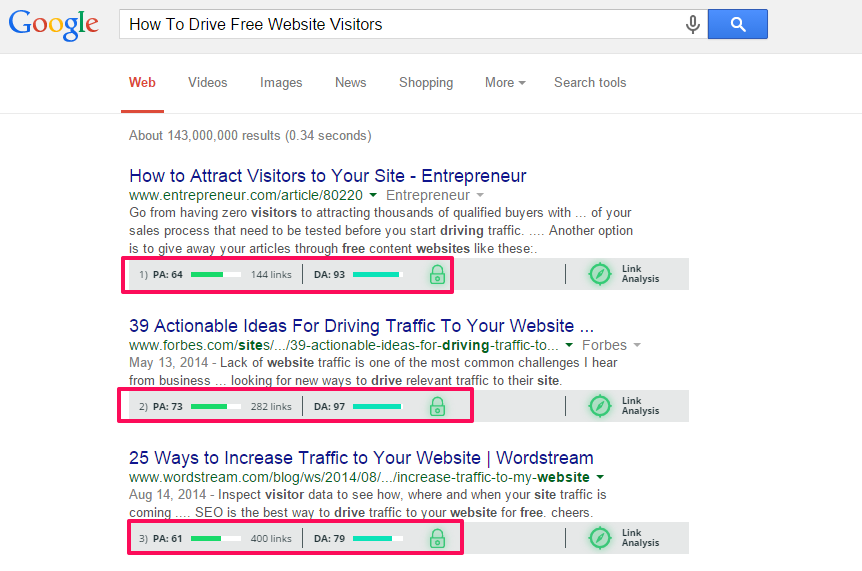
These web pages have trusted links, because the DA and PA are very high. If you still want to compete against these authority web pages, you could work to get natural links from the sites that gave them their trusted links. The best strategy is guest blogging and blogger outreach.
So, how can you pinpoint the sites that they generated their links from?
Follow these simple steps:
Step one: Click on one of the search results.
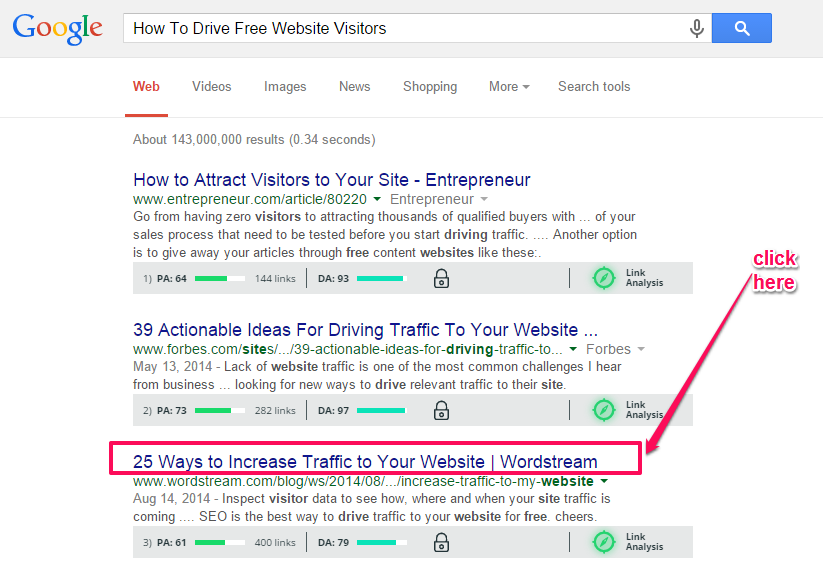
Step two: Copy the URL as it appears in the browser.

Step three: Visit Moz Open Site Explorer. Paste the URL that you copied into the search box. Click search.

Step four: Identify the linking domains and their domain authority.

There are several sites that accept guest posts, but consider their authority in the search engines, too. Personally, I wouldn’t guest blog on any blog that doesn’t rank pretty highly for my target or long-tail keywords.
Further study:
4). Social engagement: More than ever before, social signals are important SEO factors. Your target audience usually spends more time on Facebook, Twitter, Instagram and Pinterest than they do on other sites. So, you have to involve them in your content.

Social signals don’t improve your search rankings directly, but they do lead to engagement which helps your rankings. They also reduce bounce rate, send quality links back to your internal web pages and pass link juice to your pages.
When Moz published their Beginner’s Guide to SEO, Smashing Magazine tweeted it out to over 160,000 followers.

Within a short time, both rankings and organic traffic improved house and basic rental contract. In fact, the keyword “Beginner’s guide” started showing up on the first page of Google results.
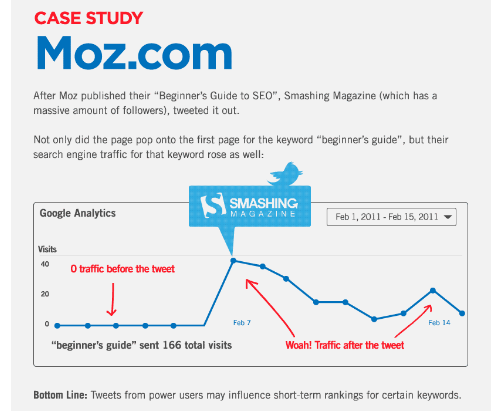
Since your headline usually appears above-the-fold, remember to use long-tail keywords in your headline. Also, use strong call-to-action instructions below-the-fold, because that’s where 65.7% of engagement happens.

Further study:
4. Long-tail Keyword Research Tools
Manual SEO is a waste of time. You don’t have to build links with fancy tools, but you can research keywords and track ranking positions with helpful SEO tools.
There are 4 important metrics that you should track with SEO software tools:

Since our goal is to generate more monthly search visitors through long-tail traffic, we need tools that will make the work easier.
Some of the tools that you can use to research long-tail keywords very quickly are:
i). Ubersuggest: This simple tool will hack different suggestion services and deliver easy-to-rank key phrases and headline ideas. If you’re stuck on what to write about or the exact key phrase to target, Ubersuggest can help.
Just type your seed keyword (e.g., small business growth) into the search box and click “select.”

ii). Keywordtool.io: You can get up to 750 long-tail variations of your keywords for free with this SEO tool. Just visit the homepage, input your primary keyword (e.g., car spray paint) and click the orange search button.

Here are the results that you’ll get:
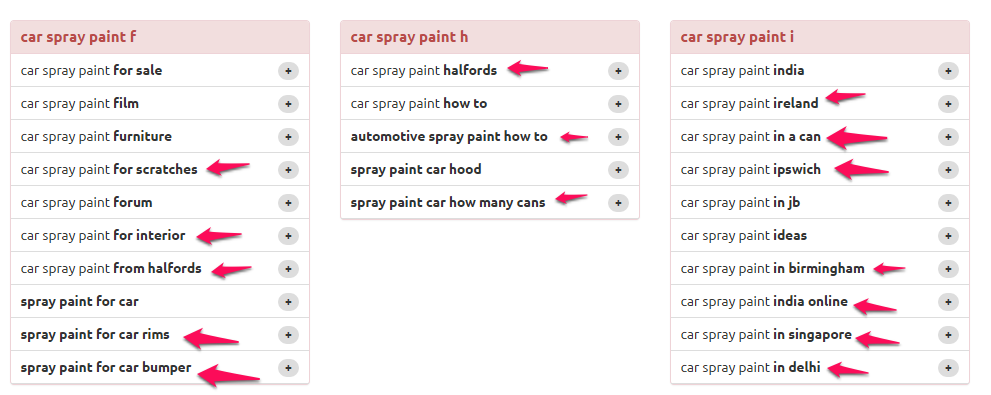
iii). Google Adwords Keyword Planner: Google’s own tool is reliable and has close to a 68% market share. This means that more searches are conducted on their search engine and stored in a secure database.
I recently discovered a simple way to use Google’s keyword planner to generate longer keyword variations. The trick is to type in a question-based keyword.
For example, if you want to rank your web pages for profitable keywords related to marketing automation, type “what is the best marketing automation software” in Google’s keyword planner.
Here are the long-tail keywords that you can target in your content:
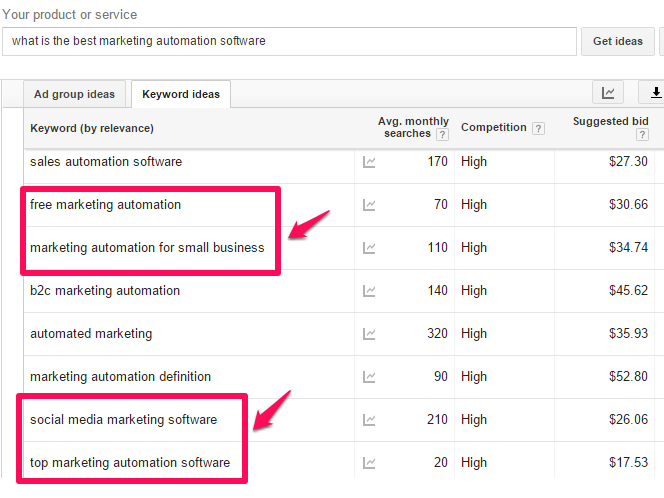
iv). Google related & auto-suggest: I’ve used auto-suggest to find keywords that helped me gain 200,000 monthly visitors.

Another option, besides the above tools, is to use regular Google search. Just type in your keyword and you’ll get relevant and less competitive long-tail keywords:

Also, scroll down the search results page to find related searches at the bottom.
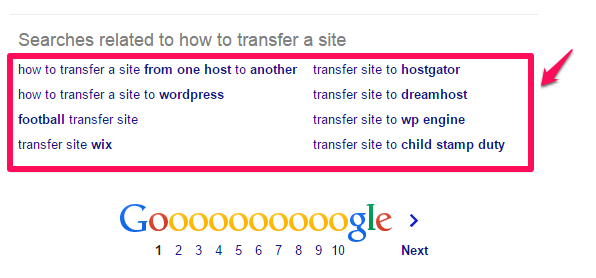
Note: Hittail is another premium keyword research tool that I use frequently directx 11 kostenlos downloaden windows 7. But, if you want to gauge your results first, without making an investment, then the free research tools above will do.
Conclusion
Some SEOs claim that there are under-the-radar secrets for improving your search rankings and traffic.
But, I’ve been targeting long-tail keywords in my blog posts, video courses and advanced guides. This strategy works.
Always remember that the main reason to conduct keyword research isn’t to manipulate search engines into ranking your web page. Instead, you want to understand what your target audience is looking for, what questions keep them up at night and what they’re thinking when they use Google search.
It all boils down to creating useful content for your users, so that they’ll be satisfied and share it with others. That’s how SEO and social shares work together to increase your sales through long-tail traffic.
Have you been driving search traffic through long-tail keywords?

